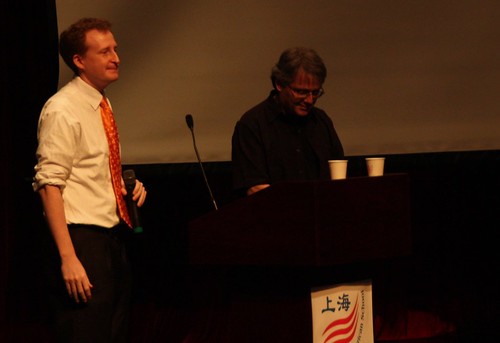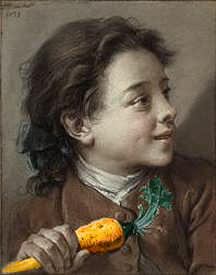4.21.2009
On Friday before the festival, Scott McCloud came to our foundations art class to participate in our class discussion about our latest project, "sequential sculpture". This lesson came about in an interesting way- I realized that we'd be well into our ceramics units while Scott was visiting- and so I wanted to create a project that would deal with some of the ideas that he talks about in his books through sculpture. Also, I was influenced by two books that I'd recently read, Shaun Tan's The Arrival, and Keith Sawyer's book Group Genius (more on that later). From The Arrival we drew our theme of culture shock, and Group Genius has inspired me to do more collaborative projects in my classes (in addition to the video classes which are collaborative by nature).
Thus our 'sequential sculpture' project was born as a collaborative project. Interestingly, I didn't find much in the way of examples that predicates this idea. Certainly there are plenty of relief sculptures that rely on sequence- Scott suggested Trajan's Column, for example. However we were looking at doing some free standing sculptures, and for that there didn't seem to be much to draw upon.
Instead we looked at Scott's Making Comics for understanding sequence and framing. We looked at Art Spiegleman's Maus for inspiration on creating anthropomorphic or abstracted characters, and discussed how that makes them more universal. We looked at Shaun Tan's The Arrival for some inspiration around our theme, and finally we looked further back into art history for some precedence of sequence and 'choice of moment' - for example, we took a look at the Merode Altarpiece and discussed the sequence there, and the interesting choice of moment - seconds before the Annunciation. We also took a quick look at some work by Louise Nevelson, Mars Tokyo, and Joseph Cornell. Nevelson's work has always struck me as looking a bit like an abstract comic, and it seemed to me that creating dioramas in sequence would be an interesting way of addressing our project- almost like a 3D comic.
Here are some highlights from our class discussion; Scott shares some insights into what is working with their project and suggests some thoughts to take their ideas further:
 Following the class visit, Scott gave a presentation to our students about the power of comics as a medium that combines image and text, and how that pairing, with the help of digital media, represents the future of visual communication. Furthermore, his presentation focused on key issues of visual literacy - the very format of the presentation was an excellent learning tool for the students. In nearly 45 minutes and over 300 slides, he presented clearly and effectively with no bullet points, no charts, and nearly no words other than the ones he spoke himself.
Following the class visit, Scott gave a presentation to our students about the power of comics as a medium that combines image and text, and how that pairing, with the help of digital media, represents the future of visual communication. Furthermore, his presentation focused on key issues of visual literacy - the very format of the presentation was an excellent learning tool for the students. In nearly 45 minutes and over 300 slides, he presented clearly and effectively with no bullet points, no charts, and nearly no words other than the ones he spoke himself. His presentation was met with a hugely enthusiastic response. Our students asked great questions about where he gets his inspiration from, what his next projects would be, and how he came up with the idea of "Homer Simpson" (that was my fault, when I introduced him I quoted Matt Groening's review of Understanding Comics - I knew that was going to happen). I was way too jazzed that he was presenting at our school to take notes- but luckily my good friends took care of that - Shaun McElroy live-blogged the event, and Amanda DeCardy posted her experience of Scott's contributions at SAS Pudong as well.
Below you can see some photos from the class visit as well as the presentation:
A big hat tip to Mikey McKillip for working his magic to get Scott here to do classroom visits and presentations at the Shanghai American School, Shanghai Community International School, and Concordia International School, Shanghai.
2 Comments:
-
- Chan Bliss said...
3:20 PMThat is a very interesting video on the sequential sculptures. I need to mull over the idea and see how I can adapt it to elementary school. At our local art teacher association last week we had a presentation from one of our teachers who did a lesson on graphic novels and using that to promote literacy. I'm sure that the kids would love to write stories about clay figures they made.- dsgran said...
4:05 PMHey Chan, thanks- I'm really pleased with what the students did with the project. I'll post some more pictures of the project when they're finished.
Subscribe to:
Post Comments (Atom)















